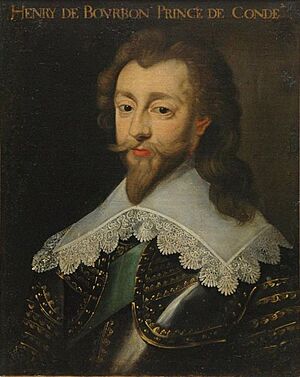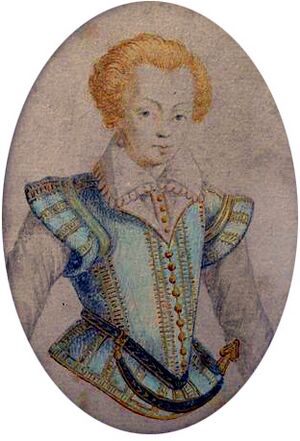Henri II, Prince of Condé facts for kids
Quick facts for kids Henri II de Bourbon |
|||||
|---|---|---|---|---|---|
 |
|||||
| Prince of Condé | |||||
| Tenure | 1 September 1588 – 26 December 1646 | ||||
| Predecessor | Henri I | ||||
| Successor | Louis II | ||||
| Born | 1 September 1588 Saint-Jean-d'Angély, Saintonge, France |
||||
| Died | 26 December 1646 (aged 58) Hôtel de Condé, Paris, France |
||||
| Spouse | Charlotte Marguerite de Montmorency | ||||
| Issue Detail |
Anne Geneviève, Duchess of Longueville Louis II, Prince of Condé Armand, Prince of Conti |
||||
|
|||||
| House | Bourbon-Condé | ||||
| Father | Henri I, Prince of Condé | ||||
| Mother | Charlotte Catherine de La Trémoille | ||||
| Religion | Roman Catholicism | ||||
| Signature | |||||
Henri II de Bourbon, Prince of Condé (1 September 1588 – 26 December 1646) was the head of the senior-most cadet branch of the House of Bourbon for nearly all his life and heir presumptive to the King of France for the first few years of his life. Henri was the father of Louis, le Grand Condé, the celebrated French general.
Contents
Life
Henri was born in 1588, the third child and only son of Henri I, Prince of Condé and Charlotte Catherine de La Trémoille, daughter of Louis III de La Trémoille, Duke of Thouars. His mother was in prison at Saint-Jean-d'Angély at the time, accused of killing her husband. He had two older sisters, namely Catherine de Bourbon, his paternal half-sister who died unwed in 1595, and Éléonore de Bourbon, who in 1606 was married, aged 19, to 51-year-old Philip William, Prince of Orange.
Henri was a posthumous child, his father having died nearly six months before his birth. He therefore became Prince of Condé within weeks of his birth, as soon as he was recognized and confirmed by the King of France.
Henri's mother was in prison for six years, accused of poisoning her husband, but never actually given a trial. Pleas of help to her family and authorities went unanswered. She and her children would only be released from their captivity after the intervention of Jacques Auguste de Thou on her behalf to the king Henry IV who was a relative of the young prince.
King Henry III of France died in August 1589, when Henri was less than one year old, and was succeeded by Henry IV of France, who was the first cousin of Henri's late father, by way of Henris grandfather Louis older brother Antoine de Bourbon having married Jeanne d'Albret (Queen of Navarre). Their son, Condé's nephew, became Henry IV of France.
Less than a year later, the new King's uncle (Henri's great uncle) and initial heir, Cardinal Charles died. At this point, Henri, being the King's closest agnatic kin, became First Prince of the blood and heir presumptive to the throne of France, and remained so for twelve years, until the birth of the future Louis XIII of France in September 1601.
Henri was raised as a Catholic at the insistence of Pope Clement VIII. Henri's father and grandfather had been leaders of the Calvinist Huguenots.
Raised at court but never regarded as a favorite and seen with suspicion by Henry VII for his potential claims to the throne. Henri grew into what his contemporary Bassompierre described as a "not amiable" young man who was quick to take offense. He much preferred hunting and the military life as opposed to court life.
His appearance and personality was described by a contemporary as;
"Small and thin, he has very prominent facial features, as all those of the House of Bourbon usually do; he is blond and has the lively French temperament. I find him witty, but he is frivolous and often imprudent in the choice of his confidants. He speaks Latin and Italian, has Spanish and speaks it a little; he is well versed in sacred and secular letters, having had Nicolas le Febvre as his tutor, and pushes his zeal for the Catholic religion very far.”
His position at court was further undermined to his relative poverty and much damaged by the court intrigues of his mother winch eventually led to her permanent banishment from court. Henri himself was made to deliver the bad news to his mother.
When in 1609 his marriage with Charlotte de Montmorency was arranged (allegedly because his uncle the king was infatuated with her and expected his nephew to be compliant with her becoming his mistress.) Because both bride and groom were first cousins, a papal dispensation was needed. This was granted and he wedding took place at the brides fathers home of Chantilly.
Afterwards instead of bringing his wife to court as the king had expected she was instead brought to first Chateau de Breteuil and then to Muret Henris home in the country where she remained under the supervision of her mother-in-law. Charlotte wrote letters to her Montmorency relatives calling herself "la pauvre prisonniere" (lit. "the poor prisoner"
The king's demands becoming more adamant that he fetch his wife to court finally succeeded and Henri asked permission to do so which the king happily granted. But instead Henri went to Muret where he had arranged a carriage and escaped with his wife to Brussels.
Some months later, in February 1610, he was obliged to remove to exile in Milan where the Spanish government was more than happy to defy the French king's request to turn over the prince. Henri took up residence in the palace of the viceroy of Milan Count of Fuentes who supplied him with a bodyguard.
Meanwhile, in Brussels, Charlotte, encouraged by French diplomats, signed a petition asking for the dissolution of the marriage to the Prince de Condé on the grounds of a disparity of temperament and inclinations. Henri opposed the divorce long enough that matters were subsequently resolved by the assassination of Henry IV.
Finally free to return to France, he returned to Paris in July 1610 after the death of his uncle the king and was greeted by many nobles and the young king Louis XIII and the queen mother Marie de Medicis. Restored to grace he was reinstated at court.
From 1612 to 1616 he was Lieutenant General of New France. He was made governor of Berry.
Imprisonment
Condé was accused of wanting to become the king through a coup and although there was no concrete evidence to back this up, Richelieu had him arrested and imprisoned in the Bastille. He was joined by his wife who wanted to share her husband's captivity.
Because of his bad health, the couple was transferred to Chateau de Vincennes. They had a stillborn son during this time, and it was feared Charlotte would die too. The couple had two more children die at birth during their imprisonment and they were not released until after the birth of their daughter Genevieve.
Later life
Later, during the years 1611–38, Henri was second-in-line to the throne of France, behind Gaston, Duke of Orleans. This was the period between the death of Nicolas Henri, Duke of Orleans in November 1611 and the birth of the future Louis XIV of France in September 1638.
Marriage and issue

In 1609, Henri married Charlotte Marguerite de Montmorency, daughter of Henri I de Montmorency, Duke of Montmorency by his second wife, Louise de Budos. In 1610, Marie de Médici, wife of King Henry IV, gave the Hôtel de Condé in Paris to Henri as part of a recompense for his agreeing to marry Charlotte. From then on, the Hôtel de Condé became the main residence of the Princes of Condé until 1764. Henri and Charlotte had three children, all of them protagonists of the Fronde, namely:
- Anne Geneviève de Bourbon (1619–1679), married Henri II d'Orléans, Duke of Longueville.
- Louis de Bourbon, Prince of Condé (1621–1686), the celebrated French general known as le Grand Condé. The Princes of Condé male line became extinct in 1830 with the death of Louis Henri II, Prince of Condé.
- Armand de Bourbon, Prince of Conti (1629–1666), married Anne Marie Martinozzi, daughter of Girolamo Martinozzi.
Reportedly, King Henry IV fancied Charlotte himself, and arranged the marriage with Condé in order to provide cover for an affair. However, Condé would have none of it, and escaped with his wife first to Brussels and later to Milan, both of which were under the rule of the House of Habsburg. The Condé affair became part of the international conflict known as the War of the Jülich Succession (one of the precursors to the Thirty Years' War).
Sources
|
Henri II, Prince of Condé
Cadet branch of the House of Bourbon
Born: 11 September 1588 Died: 26 December 1646 |
||
| French royalty | ||
|---|---|---|
| Preceded by Charles, Cardinal de Bourbon |
Heir to the Throne as Heir presumptive 9 May 1590 — 27 September 1601 |
Succeeded by Louis, Dauphin of France |
| French nobility | ||
| Preceded by Henri I de Bourbon |
Prince of Condé 5 March 1588 – 26 December 1646 |
Succeeded by Louis II de Bourbon |
| Military offices | ||
| Preceded by Charles de Bourbon, comte de Soissons |
Lieutenant General of New France 1612 – 8 October 1619 |
Succeeded by Henri II de Montmorency, admiral of France |



